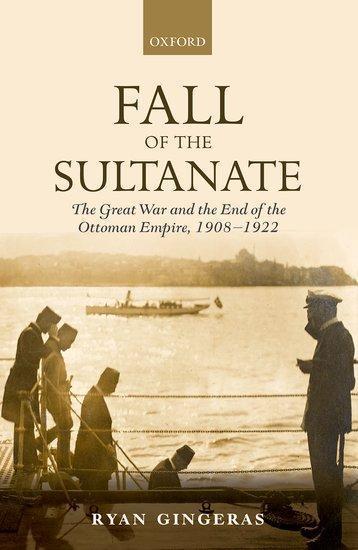The fall of the Ottoman sultanate
William Armstrong - william.armstrong@hdn.com.tr

Sultan Vahideddin (Mehmed VI) departs from the backdoor of the Dolmabahçe Palace in Istanbul. A few days after this picture was taken, the sultan was deposed and exiled on a British warship to Malta. Turkey was declared a Republic on Oct. 29, 1923, headed by President Mustafa Kemal Atatürk.
‘The Fall of the Sultanate: The Great War and the End of the Ottoman Empire, 1908-1922’ by Ryan Gingeras (Oxford University Press, 317 pages, £35)For the lands of the Ottoman Empire and later the Republic of Turkey, the Great War lasted longer than four years. The state was engaged in almost constant conflict from 1911, culminating in the War of Independence that led to the founding of the Turkish Republic in 1923. The triumph of that founding came at the painful price of Ottoman collapse after centuries of gradual decline.
 The centenary of the First World War has prompted plenty of reflection and many books. This has included welcome re-examinations of the less considered Eastern Front. “The Fall of the Sultanate” by Naval Postgraduate School historian Ryan Gingeras situates the Great War from 1914 to 1918 within a wider context of upheaval in the region ruled by the Ottoman Empire. The order that emerged from this turmoil was fragile but largely persisted until today. Today’s meltdown in the Middle East adds urgency to the reconsideration of events 100 years ago.
The centenary of the First World War has prompted plenty of reflection and many books. This has included welcome re-examinations of the less considered Eastern Front. “The Fall of the Sultanate” by Naval Postgraduate School historian Ryan Gingeras situates the Great War from 1914 to 1918 within a wider context of upheaval in the region ruled by the Ottoman Empire. The order that emerged from this turmoil was fragile but largely persisted until today. Today’s meltdown in the Middle East adds urgency to the reconsideration of events 100 years ago.Indeed, many people are doing just that. A couple of weeks ago, Turkish President Recep Tayyip Erdoğan offered a bizarre revisionist reading of the Battle of Kut, in which the Ottomans defeated the British in Iraq in 1916. Erdoğan appeared to suggest that the Ottomans did not really lose the First World War, and dark outside powers had forcibly excised glorious episodes such as Kut from Turkey’s collective memory.
Gingeras has a rather more sophisticated view. Far from glorious, the long Ottoman collapse was extraordinarily traumatic. His book aims to explore “the causes that eventually led so many to view the legacy of the Ottomans with loathing and resentment.” Within Turkey, he writes, “there has been a general tendency to see the fall of the Ottomans as a trauma exclusive to the Turkish experience … This is hardly the case. Peoples living in other successor states construe the empire’s end communally and in similarly agonizing terms.” There certainly was plenty of bitterness. Everywhere bore evidence of the carnage wrought by continuous war. “Not a single family residing in Anatolia escaped the first two decades of the 20th century without having encountered some form of personal tragedy brought on by armed conflict,” Gingeras writes.
Ottoman disintegration saw a steady drip-drip of territories and national groups breaking away from the empire. From a bewildering range of religions, ethnicities, and local arrangements, the Ottoman Empire became overwhelmingly Sunni Muslim. The autocratic Sultan Abdülhamid II (r. 1876-1909) had tried to use Islamic legitimacy to strengthen the empire until he was sidelined by the Young Turk revolution of 1908. The Young Turks were restless military officials who came to power upon a wave of enthusiasm across many parts of the Ottoman population, but demographic reality after territorial losses soon soured the mood. As the Ottoman grip on the Balkans weakened, hundreds of thousands of Muslim refugees settled in Anatolia after fleeing massacre in Serbia, Bulgaria and Greece. The misery of the greatest mass migration in the empire’s history ensured that wounds remained unsutured. After taking power the Young Turks quickly became just as autocratic as the hated Abdülhamid - and just as fixated on Muslims as the empire’s unshakable core.
The Ottoman Empire had been modernizing since the early 19th century. However, there was a paradox: Centralization was essential to pass reforms necessary for the survival of the state, but centralization exacerbated other problems and stirred the anger of various groups. A vicious cycle developed as violence spiralled in the early years of the 20th century. Sentiments everywhere hardened with wartime conditions. “War, the threat of war, and war’s immediate aftermath were factors that had a primary effect upon the politicization of communal identities and the breakdown of imperial rule,” Gingeras writes. The most cataclysmic effect was the genocide of Anatolia’s Armenian Christian population.
Any historian of this colossal subject has to keep many plates spinning at once, marshalling material over an immense geographical sprawl. Happily, Gingeras is able to do this. He takes the story up through the War of Independence that followed the Ottoman defeat in the Great War. The nationalist resistance was led by Mustafa Kemal, later Atatürk, who rejected the onerous terms of the 1920 Treaty of Sevres and ultimately secured Turkish sovereignty over Istanbul and the empire’s Anatolian core.
Earlier this year, Gingeras published a slim new biography of Atatürk, which takes the story further. Read together, the two books are full of insight into this crucial period. The Turkish Republic marked a conscious attempt to build a new state, seeing the empire as “a relic, emblematic of a painful recent and distant past.” The new country was built upon the ashes of a despised empire, but the weight of historical inheritance was heavy. The simplistic revisionism led by the current Turkish government shows that memories, though often distorted, are stubbornly long.










